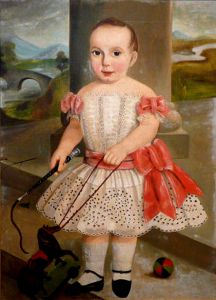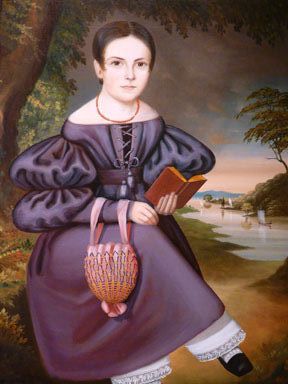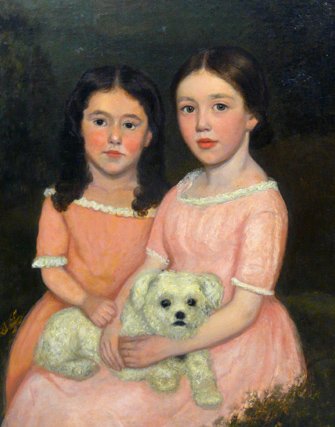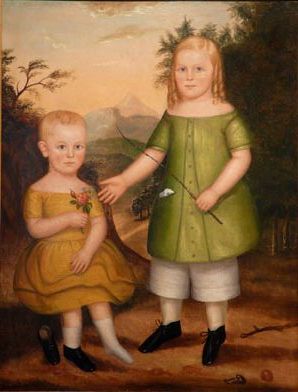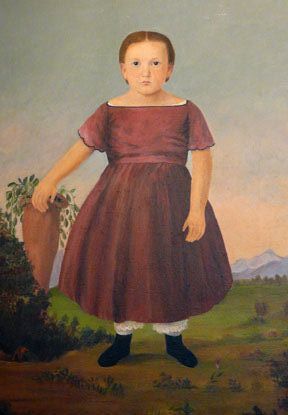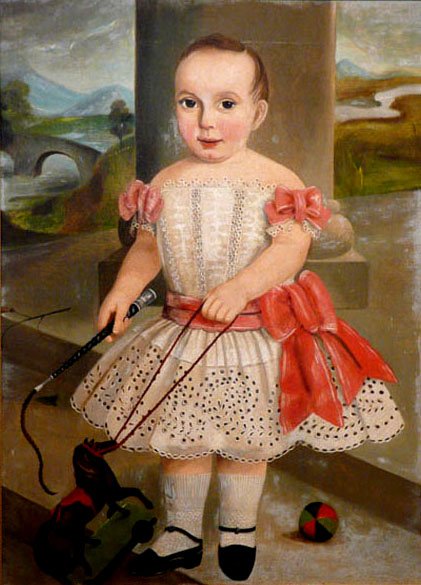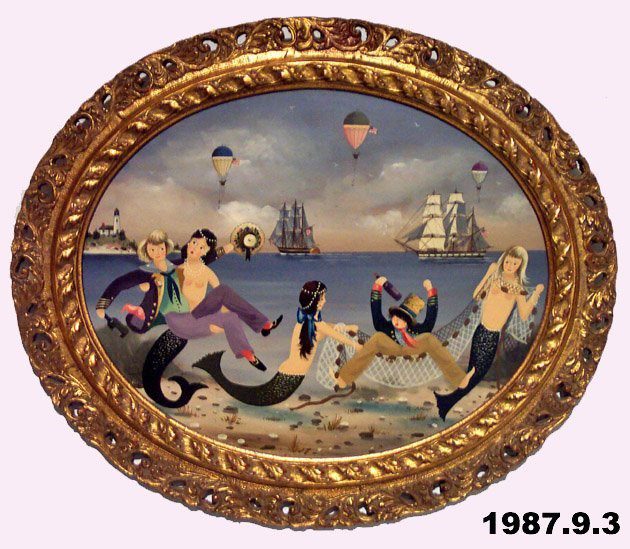From The Heritage Collection
It is easy to forget how much we rely on arbitrary social signifiers in navigating our world. When we come up against the unfamiliar conventions of other places and other times, they can seem strange or amusing or just plain wrong to our way of thinking. Folk art portraits of children from the late 1700s to the 1860s can present just such a situation, when the usual indicators of gender such as hair and clothing turn out to be unreliable.
Looking at the portrait above, what was your immediate impression? Boy or girl? Most visitors to Heritage are surprised to learn that this portrait is of a boy. As mentioned in the last post, prior to the early twentieth century, young children all dressed alike. These days children have a strong gender designation from birth—there is societal assumption that parents will dress their child in pink or blue to indicate gender. Dressing a child against the norm may cause confusion or even irritation on the part of onlookers who have a particular expectation. But children of such a young age are not sexualized beings, so in a way it makes sense to dress them all alike. Dresses may also have been more practical in terms of accommodating rapid growth and for ease of toilet training. One wonders how casual acquaintances of two centuries ago knew whether they were looking at a baby boy or baby girl out for a stroll with the new mother; presumably, they asked and felt no embarrassment at doing so.
So, if the social indicators in these portraits are not the ones we’re used to, how can we know what we’re looking at? Researchers like Heritage’s own Jennifer Madden have looked at countless child portraits for which the identity of the sitter is well established and have made some conclusions about visual markers in the paintings.
Here are some ways that DON’T work and a few that DO:
- Clothing and clothing color: As we’ve noted, boys and girls dressed alike, at least until boys were “breeched” (http://en.wikipedia.org/wiki/Breeching_(boys)) around the age of seven or so. Clothing color cannot be used as an indicator of gender in portraits, as societal notions of color meanings have shifted over time. The idea of pink being feminine and blue masculine is very recent, dating only to the early 1900s. Historically, blue was often identified with girls because of its association with the Christian Virgin Mary, while pink was considered to be a watered-down version of red, traditionally the war-like color of blood and therefore, masculinity.
- Interior / Exterior settings: Some people have proposed that boys are more likely to be pictured in outdoor settings, while girls tended to be indoors, working on the premise that a girl’s future life was in the home, while men went out into the world. You don’t have to look at many of these portraits to see that this doesn’t hold up at all.
- Props: What’s being held by child in a portrait can be useful in telling their gender, but often it isn’t the props you expect. Dogs, cats and other pets might be shown with children of either sex. Flowers, long thought to be feminine, are also held by both boys and girls, though they are more frequent among girls’ portraits. Books, which were once thought to be “boys’ props” because boys tended to get more education, appear frequently in paintings of girls. In fact, things like books, baskets and dolls that require very little active movement to play with are often associated with girls in portraits, probably because girls were expected to be quieter and more demure than their more active brothers, who might be pictured playing with balls, hobby horses and pull toys. A definite indicator of boyhood is a switch or whip. If the child is holding one of these, you can be certain it’s a boy.
- Hair: The length and style of hair can’t be used to indicate gender, since small boys went around with ringlets just as often as little girls did. But where the hair is parted—either on one side or in the center, is a good indicator. Boys, even ringletted ones, are generally shown with a side part or no part at all. Girls, on the other hand, wore their hair parted down the center regardless of how it was styled. This detail, which seems so arbitrary to us now, would have been recognized instantly by people of the time, perhaps in the same unconscious way that tells us that an infant wearing pink is a girl.
Folk art portraits began to fade from popularity around 1850 when photography became widespread. Photography had the advantages of being inexpensive, faster and more accurate than painted portraits. Some portrait artists even gave up painting to become photographers. But photography cannot rival the charm of many of these folk portraits, which combine wonderfully a specific moment in the life of the sitter with the achievements (and occasional failures) of the self-taught artist.


